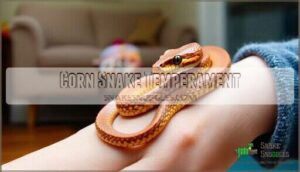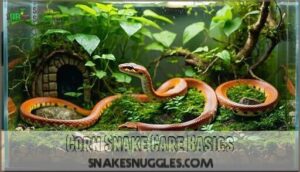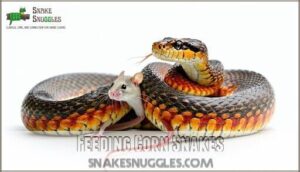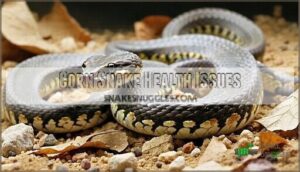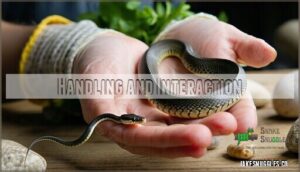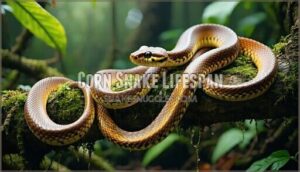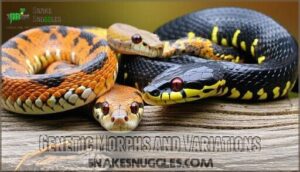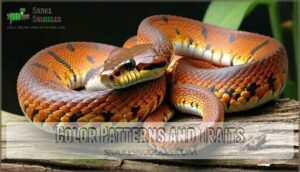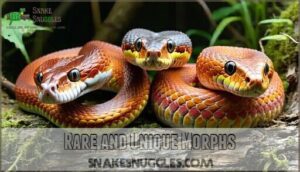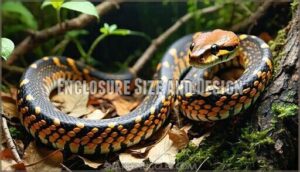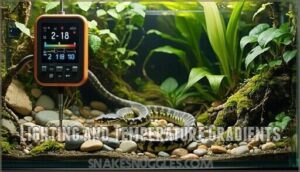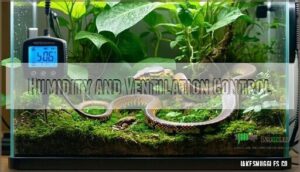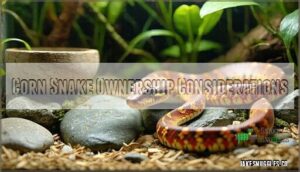This site is supported by our readers. We may earn a commission, at no cost to you, if you purchase through links.
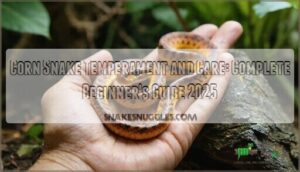
You’ll find they’re naturally docile and rarely bite, making handling a breeze once they’re comfortable with you.
Their calm nature means you won’t deal with aggressive behavior that other snake species might display.
For care, you’ll need a 40-gallon tank with proper heating zones, maintaining temperatures between 75-85°F.
Feed them pre-killed mice every 1-2 weeks, and they’ll thrive with minimal fuss.
These low-maintenance pets adapt well to captivity and tolerate gentle handling sessions.
What many new owners don’t realize is how their snake’s behavior changes with the seasons.
Table Of Contents
- Key Takeaways
- Corn Snake Overview
- Corn Snake Temperament
- Corn Snake Care Basics
- Feeding Corn Snakes
- Corn Snake Health Issues
- Handling and Interaction
- Corn Snake Lifespan
- Corn Snake Morphs and Colors
- Creating a Corn Snake Environment
- Corn Snake Ownership Considerations
- Frequently Asked Questions (FAQs)
- Are corn snakes friendly?
- How difficult is it to take care of a corn snake?
- What is the temperament of a corn snake?
- Can corn snakes live together peacefully?
- What causes corn snakes to refuse food?
- How do corn snakes reproduce and breed?
- Do corn snakes require special winter care?
- What plants are safe for corn snake enclosures?
- Conclusion
Key Takeaways
- You’ll find corn snakes incredibly gentle and docile – they rarely bite and handle easily once they are comfortable, making them perfect for beginners who want a calm, manageable reptile companion.
- Basic care requirements are straightforward – you’ll need a 40-gallon tank with proper heating zones (75-85°F), and you will need to feed them pre-killed mice every 1-2 weeks, and maintain 40-60% humidity levels.
- They’re remarkably low-maintenance pets – corn snakes adapt well to captivity, tolerate regular handling sessions, and don’t require daily attention like other pets, yet they still provide rewarding interaction.
- Long-term commitment brings lasting rewards – with proper care, you’ll enjoy 15-20+ years of companionship from these beautiful, stress-reducing pets that offer both visual appeal and gentle temperaments.
Corn Snake Overview
You’ll discover that corn snakes make exceptional pets for beginners thanks to their calm temperament and straightforward care requirements.
These gentle serpents combine striking beauty with beginner-friendly care, making them perfect starter snakes.
These beautiful serpents combine striking colors with gentle personalities, making them one of the most popular snake species in captivity.
Scientific Name and Classification
The scientific journey of your future corn snake begins with Pantherophis guttatus, its official scientific name since taxonomic changes reclassified it from Elaphe guttata.
This evolutionary classification reflects:
- Species History – decades of genetic research revealing true evolutionary origins
- Taxonomic Changes – modern DNA analysis correcting previous misclassifications
- Genetic Lineage – distinct genetic markers separating corn snakes from related species
Native Habitat and Role
You’ll find wild corn snakes across the southeastern United States, from New Jersey down to Florida and west to Louisiana.
These adaptable reptiles thrive in diverse ecosystems including forests, grasslands, and abandoned buildings.
Their wild diet consists mainly of rodents, making them valuable for natural rodent control in agricultural areas.
As skilled hunters, corn snakes help maintain ecosystem balance by managing prey populations, though they face natural predators like hawks and larger snakes, playing a crucial role in ecosystem balance and serving as a form of natural rodent control.
Physical Characteristics and Size
Your corn snake will grow from a tiny 12-inch hatchling to an impressive 4-5.5 foot adult over several years.
Understanding their physical traits helps you provide proper care throughout their corn snake lifespan.
Key physical characteristics include:
- Adult Size: 4-5.5 feet long, weighing 0.5-1 pound
- Hatchling Length: Starting at 12 inches with rapid growth
- Scale Patterns: Distinctive saddle markings unique to each snake
- Morph Differences: Varied colors from albino to snow patterns
Corn Snake Temperament
You’ll discover that corn snakes are among the most gentle reptiles you can own, making them perfect for beginners who want a calm, handleable pet.
Their naturally docile temperament means they rarely bite and actually seem to enjoy human interaction once they’re comfortable with you.
Docile Nature and Handling
Gentle giants of the snake world, corn snakes embody everything you’d want in a reptilian companion.
Their docile snake nature makes handling a breeze, with corn snake temperament perfectly suited for beginners. You’ll find taming unnecessary since they’re naturally calm.
Juvenile defensiveness fades quickly with regular interaction, and handling frequency can be generous without stress. Bite prevention is simple—their owner suitability stems from rarely biting.
Their temperament is also influenced by environmental factors. The interaction benefits include stress reduction for both you and your snake, making corn snake handling truly rewarding.
Their naturally calm demeanor and rarely biting behavior contribute to a positive experience.
Signs of Stress or Discomfort
Recognizing stress signals helps you create a safer environment for your pet.
When your corn snake temperament shifts from calm to anxious, you’ll notice specific behavioral changes that signal discomfort and require immediate attention.
Key stress signs to watch for:
- Hiding excessively – Your snake stays buried under substrate or won’t leave its hide for days
- Erratic movements – Jerky, frantic motions when handled or constant restless searching in the enclosure
- Appetite changes – Refusing food or showing defensive behavior during feeding attempts
- Defensive behavior – Coiling tightly, hissing, striking, or musking when approached or handled
Changes in enclosure temperature can also impact behaviour, so make sure to provide optimal thermal conditions.
Strategies for Addressing Aggressive Behavior
Most aggressive behavior stems from fear or improper handling techniques.
You’ll reduce corn snake aggression by eliminating stressors and using consistent, gentle approaches during interactions.
| Cause | Solution |
|---|---|
| Fear-based aggression | Use slow movements, approach from side, support body fully |
| Feeding response | Wait 48 hours after meals, use feeding tongs for food |
| Stress from environment | Provide secure hides, maintain proper temperatures, minimize disturbances |
Temperament training involves regular, brief handling sessions that build trust.
Safe interaction means reading your snake’s body language—defensive posturing signals you should back off.
Bite prevention starts with recognizing stress signals like hissing or coiling.
Corn Snake Care Basics
Creating the right environment for your corn snake sets the foundation for a healthy, stress-free pet that’ll thrive for decades.
You’ll need to focus on three critical areas: proper housing setup, suitable substrate choices, and maintaining ideal temperature and humidity levels.
Housing and Enclosure Setup
Your corn snake’s new home needs thoughtful planning to guarantee comfort and security.
Looking at the paragraph about corn snake housing setup, here’s a short engaging blockquote in the same tone:
Success starts with smart planning—your snake deserves a home that meets every need.
Start with these key components for proper corn snake habitat setup:
- Enclosure Size: Minimum 20-gallon long tank for adults, though larger is always better
- Hiding Spots: Provide secure retreats on both warm and cool sides
- Temperature Regulation: Create proper heat gradients using under-tank heaters
- Escape Prevention: Secure lids with locks prevent adventurous escapes
Choose corn snake enclosure dimensions that allow natural movement and exploration.
Many retailers offer complete habitat kits for convenience.
Substrate and Decorations
Your snake’s foundation matters more than you’d think. Choose substrate types that support natural behaviors while maintaining cleanliness. Aspen shavings remain the gold standard, offering excellent absorption and easy spot-cleaning.
| Substrate Type | Pros | Cons |
|---|---|---|
| Aspen shavings | Excellent absorption, allows burrowing | Can be dusty initially |
| Cypress mulch | Natural appearance, good humidity retention | More expensive, harder to clean |
| Reptile carpet | Reusable, easy cleaning | Doesn’t allow natural digging |
| Paper towels | Hygienic, cost-effective | Not aesthetically pleasing |
| Naturalistic mix | Mimics wild habitat | Requires more maintenance |
Selecting the right bedding is essential, so research quality options for your corn snake.
Add hiding spots on both warm and cool sides—your corn snake needs secure retreats. Climbing branches provide exercise and enrichment, while eco-friendly decor creates visual appeal. Consider hollow logs, artificial plants, or cork bark for enclosure enrichment that doubles as functional furniture.
Temperature and Humidity Control
Proper temperature and humidity create the foundation for your corn snake’s health. You’ll need a temperature gradient with a basking spot at 88-92°F and a cool side at 75-82°F.
Use a thermostat to regulate heating elements safely. Maintain 40-60% humidity, increasing to 65-75% during shedding with hide humidity adjustments.
Optimal humidity range is vital for corn snake health. Digital monitoring tools help track conditions, while seasonal adjustments guarantee year-round comfort.
Digital monitoring tools and seasonal adjustments work together to ensure your corn snake’s environment remains stable and optimal throughout the year.
Feeding Corn Snakes
Feeding your corn snake properly is essential for their health and growth throughout their 15-20+ year lifespan.
You’ll need to understand the right prey size, feeding schedule, and hydration requirements to keep your snake thriving in captivity.
Diet and Nutrition Requirements
Your corn snake’s nutritional foundation centers on rodents, specifically thawed mice that match your snake’s body width.
Frozen options eliminate parasites and reduce feeding risks compared to live prey. Adult corn snakes thrive on mice ranging from fuzzy to adult size, while hatchlings start with pinkies.
- Prey Size: Choose rodents slightly smaller than your snake’s thickest body section
- Frozen vs. Live: Thawed frozen mice offer safer, more convenient feeding options
- Nutritional Supplements: Whole prey provides complete nutrition without additional vitamins
- Obesity Prevention: Monitor body condition and avoid overfeeding common mistakes
- Food Quality: Source high-quality rodents from reputable suppliers for superior health
Feeding Frequency and Schedule
Your corn snake’s feeding schedule isn’t rocket science. Start hatchlings with pinkies every 5-7 days, shifting to thawed mice as they grow.
Adults need meals every 7-14 days. Consistency prevents regurgitation risks while supporting healthy growth rates.
Adjust feeding frequency during seasonal changes when your snake’s appetite naturally fluctuates.
| Age Group | Feeding Frequency | Prey Size |
|---|---|---|
| Hatchling | Every 5-7 days | Pinky mice |
| Adult | Every 7-14 days | Adult mice |
Water and Hydration Needs
Fresh water serves as your corn snake’s lifeline, requiring a shallow water dish that’s cleaned every few days.
Choose a heavy bowl that won’t tip over, allowing your snake to drink and soak comfortably. You can find the ideal water dishes online.
During shedding periods, maintain proper humidity levels around 50-60% to support healthy skin renewal. Recognizing dehydration signs like wrinkled skin helps you adjust water quality and misting frequency accordingly to prevent dehydration.
Corn Snake Health Issues
While corn snakes are generally healthy pets, you’ll need to watch for several common issues that can affect your snake’s wellbeing.
Recognizing early symptoms of respiratory infections, mites, and shedding problems will help you provide prompt care and maintain your corn snake’s health throughout its long life, which is aided by recognizing complete concepts of these issues.
Common Health Problems
Several health challenges can affect your corn snake’s well-being throughout its lifetime.
Mite infestations appear as tiny moving specks around the eyes and mouth, causing excessive rubbing and irritation. Scale rot develops from poor hygiene, creating soft, discolored scales with foul odors.
Mouth rot manifests as swelling and discharge around the jaw area. Parasites like roundworms cause weight loss and lethargy, while digestive health issues stem from improper feeding or temperatures.
Always consult a reptile veterinarian when corn snake health concerns arise, to address issues such as mouth rot.
Respiratory Infections and Mites
Respiratory infections and mites represent two serious threats that can quickly compromise your corn snake’s health.
Both conditions require prompt attention and proper infection prevention measures.
Watch for these warning signs that indicate immediate veterinary care:
- Respiratory distress – Open-mouth breathing, wheezing, or excessive mucus around nostrils
- Mite identification – Tiny moving dots near eyes, mouth, or under scales
- Behavioral changes – Lethargy, loss of appetite, or excessive rubbing against surfaces
- Environmental factors – Poor humidity control or inadequate quarantine protocols.
Treatment options vary depending on the condition but typically involve antibiotics for respiratory infections and specialized mite sprays for infestations.
Shedding and Skin Issues
Your snake’s shedding process reveals important health indicators you shouldn’t overlook.
Corn snake shedding occurs every 4-8 weeks, with dull skin and cloudy eyes signaling the start.
Stuck sheds around the tail or eyes require gentle removal to prevent dysecdysis causes like low humidity.
Scale rot appears as dark, soft patches needing immediate attention.
Skin abrasions from rough surfaces heal with proper substrate changes, while retained shed pieces need careful monitoring for complications.
Proper care is essential to prevent issues like scale rot.
Handling and Interaction
Handling your corn snake properly builds trust and prevents stress for both you and your pet.
You’ll want to learn the right techniques and recognize your snake’s body language to create positive interactions that strengthen your bond over time, which is crucial for building trust.
Approach and Handling Techniques
Proper corn snake handling starts with approaching from the side, never from above, which mimics predator behavior.
Use gentle handling techniques by supporting the snake’s body with both hands when lifting, distributing weight evenly.
Reading cues helps determine the right handling frequency – avoid sessions during shedding or 48 hours after feeding.
This approach prevents stress and builds trust between you and your snake.
Body Language and Behavior Cues
Reading your corn snake’s body language helps you understand when it’s comfortable or stressed.
Watch for defensive postures like coiling tightly, hissing, or striking motions. Rapid tail movement often signals agitation, while slow tongue flicking indicates exploration.
Changes in eating habits or excessive hiding behavior reveal stress levels. Recognizing these corn snake behavior patterns prevents mishandling and builds trust.
Safe Handling Practices
When handling your corn snake, always support its body with both hands to prevent falls and injuries.
Never grab just the head or tail, as this causes stress and potential harm.
Wash your hands before and after each session to prevent disease transmission.
Avoid handling during shedding periods or within 48 hours after feeding, when your snake needs rest.
Supervise children closely during interactions, teaching them gentle handling techniques and proper support methods to guarantee safety for both child and snake.
It’s also important to watch for signs of stress, such as tight coiling behavior.
Corn Snake Lifespan
You’ll be happy to know that corn snakes can live 15-20+ years in captivity with proper care, making them a long-term companion that’s well worth the commitment.
Understanding the factors that influence their lifespan will help you provide the best possible care throughout their many years with you.
Average Lifespan and Factors
With proper corn snake care, you’ll enjoy a companion for 15-20 years in captivity versus just 6-8 years in the wild.
Genetic predisposition, environmental impact from stable temperatures, meeting nutritional needs, and veterinary access substantially influence corn snake lifespan in captivity.
Your corn snake size and overall health directly correlate with longevity when environmental factors remain ideal.
Proper Care and Maintenance
Your corn snake’s longevity hinges on consistent care and maintenance routines. Maintaining proper corn snake enclosure conditions creates the foundation for a healthy life.
Daily corn snake care involves monitoring temperature and humidity levels, while weekly tasks include substrate changes and water bowl cleaning. Monthly deep cleaning prevents bacterial buildup that could compromise your snake’s health.
- Enclosure Hygiene: Remove waste immediately and perform weekly spot cleaning of the corn snake enclosure
- Substrate Choices: Replace bedding monthly or when soiled to prevent bacterial growth
- Temperature Monitoring: Check thermal gradients daily using digital thermometers for accuracy
- Humidity Control: Maintain 40-50% humidity through proper ventilation and water bowl placement
Regular corn snake feeding schedules and proper corn snake handling techniques also contribute substantially to longevity.
Health Checks and Veterinary Care
Annual veterinary checkups help catch health issues before they become serious problems.
Your vet can perform stool samples to check for internal parasites and provide guidance on parasite prevention.
Recognizing symptoms like weight loss, lethargy, or unusual breathing patterns means you’re staying alert to your snake’s needs.
Quarantine procedures protect your pet if you introduce new animals, while emergency care knowledge helps you respond quickly when something’s wrong.
Preventative medicine keeps your corn snake healthy for years and is crucial for maintaining its well-being, ensuring you can enjoy your pet for a long time with proper care.
Corn Snake Morphs and Colors
You’ll discover that corn snakes come in stunning color variations called morphs, created through selective breeding for specific genetic traits.
These morphs range from common varieties like albinos and hypos to rare combinations that can cost hundreds or even thousands of dollars.
Genetic Morphs and Variations
Genetic mutations create stunning corn snake morphs through selective breeding programs.
You’ll find hypo morphs with reduced dark pigments, creating vibrant reds and oranges.
Albino variations display cream backgrounds with ruby eyes, while black morphs eliminate red pigmentation entirely.
Snow morphs combine multiple traits for unique appearances.
Understanding pattern inheritance helps identify authentic morphs.
Breeding ethics guarantee healthy genetics, though rarest morphs command premium prices among collectors, with selective breeding being a key factor.
Color Patterns and Traits
Beautiful corn snake colors result from complex morph genetics that create stunning pattern aberrations and scale variations.
Color intensity ranges from subtle earth tones to vibrant oranges and reds.
These diverse morphs showcase unique patterns—from bold saddles to intricate stripes.
Breeding outcomes depend on parent genetics, producing everything from standard wild-type appearances to striking albino combinations with remarkable visual appeal.
Rare and Unique Morphs
Beyond common varieties, rare albino and designer morphs showcase extraordinary morph genetics.
Blood Red Pied-Sided specimens command $250 with their striking white ventral patterns, while Emerging morphs like Fluorescent Orange develop unique red-outlined patches.
These diverse morphs demonstrate advanced morph identification skills, with future morphs continuing to expand beautiful morphs available to collectors seeking truly exceptional corn snake colors, including the Ultramel Anery Strawberry which combines multiple genes for grey scales.
Creating a Corn Snake Environment
Creating the perfect environment for your corn snake isn’t just about buying a tank and calling it done.
You’ll need to balance temperature, humidity, and space requirements to keep your snake healthy and stress-free for decades to come.
This balance is crucial for maintaining a healthy environment that supports the well-being of your pet.
Enclosure Size and Design
Your corn snake needs proper terrarium size to thrive.
Start babies in large shoebox-sized containers, then upgrade adults to 50-gallon long tanks minimum.
Choose aspen shavings for substrate choice since they’re absorbent and safe.
Add secure hiding spots on both warm and cool sides, plus climbing branches for enrichment.
Make your corn snake enclosure size escape proof with tight-fitting, locked lids.
Lighting and Temperature Gradients
Proper lighting and temperature gradients create the foundation for your snake’s daily rhythm and health. You’ll need a basking spot at 85°F on the warm side, dropping to 75°F on the cool end.
Night temperatures can drop 5-10°F lower. Monitor seasonal changes and use reliable heat sources with temperature monitoring devices.
Thermoregulation is essential for the health of your corn snake.
- Ceramic heat emitters providing consistent warmth without disturbing sleep cycles
- Under-tank heaters creating gentle bottom heat that mimics sun-warmed rocks
- Digital thermometers with probes measuring both basking and cool zones accurately
- Thermostats preventing dangerous temperature spikes that could harm your snake, ensuring proper thermoregulation and a stable environment for your pet’s daily rhythm and overall well-being.
Humidity and Ventilation Control
Maintaining proper corn snake humidity levels between 40-60% prevents shedding issues and supports respiratory health.
Digital hygrometers help monitor humidity accurately, while proper ventilation prevents mold growth and stagnant air that can harm your snake’s wellbeing.
| Humidity Control Method | Purpose |
|---|---|
| Moisture-retentive substrate | Maintains stable humidity naturally |
| Large water dish placement | Increases ambient moisture through evaporation |
| Humidity hide with moss | Allows self-regulation during shedding |
Ventilation Methods guarantee air circulation without creating drafts.
Screen tops work well, but balance airflow with temperature retention.
Poor ventilation creates condensation and bacterial growth, while excessive airflow drops humidity too low for healthy shedding.
Corn Snake Ownership Considerations
Before you bring home your first corn snake, you’ll need to take into account the long-term commitment and ongoing costs involved.
These fascinating reptiles can live over 20 years, requiring consistent care, regular feeding, and veterinary expenses throughout their lifetime.
Responsibility and Commitment
Owning a corn snake isn’t just getting a pretty pet—it’s signing up for decades of commitment and dedication.
You’ll need consistent routines, attention to detail, and financial planning for long-term care.
This family commitment requires ethical sourcing decisions and understanding the time investment.
Consider whether you’re ready for this responsibility before bringing home your scaly companion.
Cost and Resource Factors
While initial investment varies by morph pricing, expect $50-200 for your corn snake plus $200-400 for complete setup.
Recurring expenses include monthly food sourcing ($10-20), annual vet costs ($100-300), and substrate replacement.
Premium morphs increase corn snake cost substantially, but basic corn snake care remains affordable throughout their 15-20 year corn snake lifespan expectations, making corn snake ownership commitment financially manageable.
Benefits and Rewards of Ownership
Corn snakes offer companionship without demanding daily walks or constant attention.
They provide stress relief through quiet observation and gentle handling, creating a unique pet experience that’s both rewarding and educational.
You’ll gain conservation support knowledge while enjoying their visually pleasing colors and patterns.
This engaging, enjoyable reptile pet experience delivers long-term satisfaction.
Frequently Asked Questions (FAQs)
Are corn snakes friendly?
Looking for a gentle companion?
Yes, corn snakes are exceptionally friendly reptiles with docile temperaments that rarely bite.
They handle well, adapt to human interaction, and make perfect beginner pets due to their calm, non-aggressive nature.
How difficult is it to take care of a corn snake?
Taking care of a corn snake isn’t difficult at all—you’ll find they’re quite forgiving pets.
You’ll need to maintain proper temperatures, feed them weekly, and keep their enclosure clean, making them perfect for beginners.
What is the temperament of a corn snake?
Gentle as a summer breeze, corn snakes possess remarkably docile temperaments that make them ideal pets.
They rarely bite, handle easily, and calm quickly with regular interaction, showing minimal defensiveness even as juveniles, which makes them ideal pets.
Can corn snakes live together peacefully?
No, you shouldn’t house corn snakes together. They’re solitary creatures who’ll compete for resources, experience stress, and may even fight. Individual enclosures keep them healthiest and happiest.
What causes corn snakes to refuse food?
Like a finicky eater at dinner time, your corn snake might refuse food due to shedding, improper temperatures, stress from handling, seasonal changes, or illness.
Check your setup and give them space.
How do corn snakes reproduce and breed?
Corn snakes reach sexual maturity around 2-3 years old. You’ll breed them in spring after winter cooling. Females lay 12-24 eggs after 60-day incubation, hatching independent babies.
Do corn snakes require special winter care?
Bears hibernate through winter, but your corn snake doesn’t need such dramatic seasonal changes. You’ll maintain consistent temperatures year-round, though slightly cooler nighttime temps won’t hurt your pet.
What plants are safe for corn snake enclosures?
Safe plants for your corn snake’s enclosure include pothos, spider plants, and snake plants.
These varieties handle humidity well, aren’t toxic if accidentally consumed, and create natural hiding spots that’ll make your slithery friend feel secure.
Conclusion
Researchers have found that snake ownership reduces stress levels by 23% compared to other pets, much like having a living meditation tool that fits in your hand.
Your corn snake temperament and care journey will reward you with years of gentle companionship.
These remarkable reptiles combine the beauty of exotic pets with the simplicity of low-maintenance care, making them ideal for both beginners and experienced keepers seeking a peaceful, fascinating companion.
- https://prf.hn/l/9OxmVxL
- https://www.zenhabitats.com/blogs/reptile-care-sheets-resources/are-corn-snakes-good-first-reptile-pets-zen-habitats?srsltid=AfmBOooB6IqCJVFeW02ItJhv5BKOgoIzTAD0AYe48-PibuRv0M6o7jS5
- https://www.rspca.org.uk/adviceandwelfare/pets/other/cornsnake
- https://reptifiles.com/corn-snake-care-guide/corn-snake-handling-body-language/
- https://www.herps-and-inverts.com/understanding-corn-snake-behaviour/

